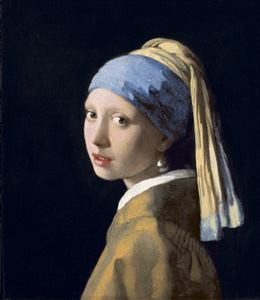On January 26, the de Young Museum became the first North American venue to present Girl with a Pearl Earring: Dutch Paintings from the Mauritshuis, a selection of paintings from the Royal Picture Gallery Mauritshuis in The Hague.

Johannes Vermeer (1632–1675) Girl with a Pearl Earring, ca. 1665, oil on canvas, 17 1/2 x 15 3/8 in. Bequest of Arnoldus des Tombe, 1903 (inv. no. 670). Image courtesy of the Royal Picture Gallery Mauritshuis, The Hague.
By Paul Duclos
Published: February, 2013
On January 26, the de Young Museum became the first North American venue to present Girl with a Pearl Earring: Dutch Paintings from the Mauritshuis, a selection of paintings from the Royal Picture Gallery Mauritshuis in The Hague. The de Young will host 35 paintings from the collection, including the renowned Girl with a Pearl Earring by Johannes Vermeer, The Goldfinch by Carel Fabritius, and four works by Rembrandt van Rijn. Highlighting the spectacular artistic achievements of the Dutch Golden Age, these works reflect the culture of artistic, economic, and technological innovation that allowed the Netherlands to prosper in the 17th century.
At the center of this exhibition is one of the world’s most famous paintings, Vermeer’s masterpiece, Girl with a Pearl Earring. This work, sometimes called "the Dutch Mona Lisa," is one of only 36 known paintings by the artist and rarely travels outside the Netherlands. Though little is known about Vermeer’s life, the quiet grace and virtuoso technique evident in his paintings, and in particular his rendering of light, have placed him among the most important artists of the 17th century. Many of the details of his technique can only be appreciated through close examination of the painting surface, such as the few tiny brushstrokes that indicate the reflection on the pearl, and the broader, more expressive painting of her ultramarine and yellow turban.
During the Dutch Golden Age, a significant shift occurred in both the technique of painting and in subject matter, particularly as secular subjects began to replace religious themes. Portraiture focused increasingly on ordinary people, like the man depicted in Rembrandt van Rijn’s Portrait of an Elderly Man. The sitter seems not to be posed, but presented in a matter-of-fact way that differs from the idealized formality of traditional portraiture. The hierarchical social structure in other European countries no longer monopolized art production in the Netherlands during this time, and as the middle class prospered, an unprecedented market for portraiture developed. Successful individuals, married couples, and civic leaders wanted likenesses to pass on to posterity.
Like the more relaxed approach to portraiture, the paintings known as genre scenes also mirrored life as it was actually lived in the Netherlands. These often depicted some aspect of everyday life, like informal musical performances or simple domestic activities. Jan Steen’s painting The Oyster Eater is an example of telling a story using a domestic setting. Lavish detail is used to depict the space, furnishings, and costume. However, as is often the case with Dutch paintings, something more is going on: the young woman looks out to the viewer with a coy glance that is open to interpretation. Is her meal simply interrupted or does she also invite us to join her in eating oysters—the food of seduction?
A Bookworm’s Dream Come True
In the annual celebration of the printed word, the 45th California International Antiquarian Book Fair returns to San Francisco on Friday, February 15, through Sunday, February 17 at the Concourse Exhibition Center in San Francisco.
Sponsored by the Antiquarian Booksellers’ Association of America (ABAA) and the International League of Antiquarian Booksellers (ILAB), the three-day event is the world’s largest antiquarian book fair, offering something for book lovers and collectors of all stripes. More than 200 booksellers from the United States and around the globe will share their collections and treasures including books, manuscripts, maps and other types of printed materials such as incunabula, fine bindings, children’s and illustrated books, ephemera and more. Fascinating antiquarian books covering all types of subjects, such as law, architecture, cookery, history, science, politics and many more will be available to peruse and purchase.
This year’s Book Fair will include a special focus on Asian books, manuscripts and artifacts, including seminars and an extraordinary exhibit of materials created just for the fair. The Asian exhibit will offer a sampling of Chinese, Japanese and Korean imprints, manuscripts, graphics and objects dating from the eighth century into the twentieth from the rare book room of the C. V. Starr East Asian Library at U.C. Berkeley—the second largest academic collection of East Asian materials in North America.

